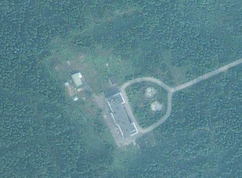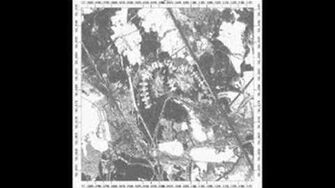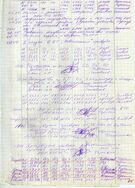UVB-76, a.k.a "The Buzzer"[]

Satellite photo of "The Buzzer's" previous location. On the outskirts of Povarovo, a small town 19 miles from Moscow.
The nickname that radio listeners have given a radio station. The transmissions could be coming one of three possible sites:
- Kirsino, a small Russian village located close to St. Petersburg. The small village has a population of 39 people.
- Near the Estonian border lies Pskov Oblast. This is currently the most likely source of UVB-76, due to the multiple triangulation attempts that lead here.
- The last attempts put it very close to a transmitter array southeast of Kolpino that is reportedly used by the Russian government to transmit state radio across Russia.
History[]
Sometime in 1982 "The Buzzer " began broadcasting at a frequency of 4625 kHz. It was a repeating 2 second pip, changing to a buzzer in the early 1990's. It changed to a higher tone with longer duration on 16 January 2003; approximately 20 tones per minute where reported. It has since reverted to the previous tone pattern.
The broadcast is a monotonous buzzing tone, repeating at a rate of approximately 25 tones per minute, for 24 hours per day. This transmitted using AM with a suppressed lower sideband (R3E), but it has also used double-sideband AM

Radio Station UVB-76 (The Buzzer)
Radio Station UVB-76 (The Buzzer)
(A3E). The sound lasts 1.2 seconds, pausing between 1-1.3 seconds, and repeats 21-34 times per minute.
On November 2010, the tones lasted aproximately 0.8 seconds each. One minute before the hour, the repeating tone was replaced by a continuous, uninterrupted alternating tone, which continues for 1 minute before the short repeating buzz resumes; although this hasn't occurred since June 2010.
Voice Messages[]
On very rare instances there have reports of voice transmissions interrupting the signal.
The voices were first reported at 9:58 p.m. GMT on 24 December 1997, after 15 years of only tones and buzzes, a male voice speaking Russian repeated the following message several times:
“Ya — UVB-76. 18008. BROMAL: Boris, Roman, Olga, Mikhail, Anna, Larisa. 742, 799, 14″.
On 12 September 2002 another voice broke the silence. This time so distorted that only part of the message could be understood.
“UVB-76, UVB-76. 62691 Izafet 3693 8270″
The third recorded voice message was 21 February 2006 the transmission received said:
“75-59-75-59. 39-52-53-58. 5-5-2-5. Konstantin-1-9-0-9-0-8-9-8-Tatiana-Oksana-Anna-Elena-Pavel-Schuka. Konstantin 8-4. 9-7-5-5-9-Tatiana. Anna Larisa Uliyana-9-4-1-4-3-4-8.”
Unusual Broadcasts[]
When listening to the broadcast on occasion distant conversations and other background noises can be heard behind the buzzer. This would suggest that the sound is transmitted from a device placed behind a live and constantly open microphone and not internally generated. There is also the chance of it being accidentally activated.
3 November 2001 a conversation in Russian was received, "Я – 143. Не получаю генератор." "Идёт такая работа от аппаратной." ("I am 143. Not receiving the generator (oscillator)." "That stuff comes from hardware room.").
11 November 2010, intermittent conversations were accidentally transmitted and recorded by a listener at 1400 UTC for a period of approximately 30 minutes. The conversations seemed to be in Russian:
- First call:
- Sudak: inaudible
- Caller: asks to speak to a duty officer of a brigade
- Sudak: inaudible
- Duty officer of Sudak: Duty officer of inaudible Sudak inaudible
- Caller: Duty officer of inaudible Nadezhda, warrant officer Nikolaeev. We have lost inaudible(signal?) with Sudak, Nadezhda-Sudak. Vulkan also lost it. Right now Vulkan is trying to figure out the problem.
- Duty officer of Sudak: inaudible
- Caller: Yes, Vulkan-Sudak. Somewhere between Vulkan and Sudak is a problem.
- Duty officer of Sudak: OK, inaudible
- Caller: Did not understand.
- Duty officer of Sudak: inaudible
- Caller: Yeah, I have to call to all the inaudible there is only a duty mechanic on duty. Do I have to call him?
- Duty officer of Sudak: inaudible
- Caller: OK I got it.
- Second call:Asking for a duty officer, but gets a reply that he is busy right now.
- Third call:
- Woman: Sudak 23. I'm listening, Sudak.
- Caller: No one answered me. Not the communication officer nor the duty officer
- Woman: Did you ask for communication officer?
- Caller: I asked for duty officer, but I was told that he is with communication officer and is busy.
- Woman: OK, wait a minute.
- now someone else takes the phone at Sudak 23
- Sudak 23: inaudible
- Caller: This is inaudible Nadezhda, inaudible. I did not get it, inaudible real time control call?
- Sudak 23: Once again, did not understand.
- Caller: Are you going to do the control call right now?
- Sudak 23: Yes, yes, yes inaudible
- Caller: Ok, I understood.
Afterward, they perform a series of control calls. A control call is when duty officer is asked for, the caller says their rank and name. The phone calls mentioned the "brigade operative officer on duty", the communication nodes "Debut", "Nadezhda" (Russian for "hope", both a noun and a female name), "Sudak" (a kind of river fish and also a town in Crimea) and "Vulkan" (volcano). The female voice says "officer on duty of communication node Debut senior ensign Uspenskaya, got the control call from Nadezhda OK". The names in the message are used by some Russian spelling alphabets, although some speculate it's a Numbers Station, transmitting encoded secrets to spies. No one has yet to decoded the messages and the stations purposes has never been confirmed by broadcast or government officials. The former Misister of Communications and Informatics of the Republic of Lithuania Rimantas Pleikys has stated that voice messages are used to confirm operators at a station are alert. Other claims are that it's monitored by military commissariats.
The Russian Journal of Earth Sciences described an observatory that used 4625 kHz to measure changes in the ionosphere. That does not explain the voice broadcasts. The solitary letter stations and the related pip/buzzer like stations, would have made them likely to be channel markers for Russian military stations, like Navy Kaliningrad (P). A channel marker is used to keep a frequency occupied, thereby making it unattractive for other potential users. This does not explain the continued expenditure on this public transmission since the internet offers cheap, reliable, secure communication. But it's worth noting that the transmission has been maintained consistently and at high power for over 30 years.
Former Location[]

The radio log found at Povarovo.
Solnechnogorsk and 40 kilometres (25 mi) northwest of Moscow, near the village of Lozhki. The location and callsign were unknown until the first known voice broadcast of 1997. In September 2010, the station's transmitter was moved to near the town of Pskov. This may have been due to a reorganization of the Russian military.
In 2011 a group of urban explorers explored the abandoned buildings at Povarovo. They claimed it is an abandoned military base. A radio log record was found, confirming the operation of a transmitter at 4625 kHz.
References[]
- "The Buzzer". October 2014. Retrieved October 1, 2014.
- "Numbers Station Research". The NSRIC. Retrieved February 21, 2015.
- Peter Savodnik (September 27, 2011). "Inside the Russian Short Wave Radio Enigma". Wired. Retrieved October 7, 2011.
- "Russian HF Beacons". Thirty-second edition of the N&O column / Spooks newsletter. 2000-12-24. Retrieved 2010-08-26.
- "Morse Stations". Seventy-fifth edition of the N&O column / Spooks newsletter. 2004-08-02. Retrieved 2010-08-27.
- Russia (2009-07-21). ""The Buzzer" (UVB-76) – Google Sightseeing". Googlesightseeing.com. Retrieved 2012-10-09.
- "August 23, 2010 9:35AM PST Voice transmission confirmed".
- "UVB-76 2010-11-11 14.00 UTC". Retrieved 11 October 2012.
- "Translation by a Reddit user". Retrieved 3 August 2014.
- O'Callaghan, Jonathan (2014-12-31). "Can YOU solve the mystery of UVB-76?". Daily Mail. Retrieved 2015-01-1
- UVB-76 From Wikipedia, the free encyclopedia
Links[]
- Number Stations: Research and Information Center; "The Buzzer"
- Thirty-second edition of the N&O column / Spooks newsletter (Sun, 24 Dec 2000 11:43:47 +0100)
- Seventy-fifth edition of the N&O column / Spooks newsletter (Mon, 02 Aug 2004 21:56:19 +0000)
- googlesightseeing.com - “The Buzzer” (UVB-76)
- "August 23, 2010 9:35AM PST Voice transmission confirmed".
- UVB-76 2010-11-11 14.00 UTC
- Translation of "UVB-76 2010-11-11 14.00 UTC"
- A sign in one of the military commissariat (4625 kHz)
- The Daily Mail - Can YOU solve the mystery of UVB-76?
- UVB-76 From Wikipedia, the free encyclopedia